Folklore is at the very heart of Baltic culture. Indeed, until the 19th century, folklore in effect was Baltic culture, because German and Polish rule from the Middle Ages onwards had meant that no real indigenous literary culture had been able to evolve. In the 19th and 20th centuries, the Baltic scholars and writers who developed the new Baltic cultural identity primarily used peasant folklore as their starting point.
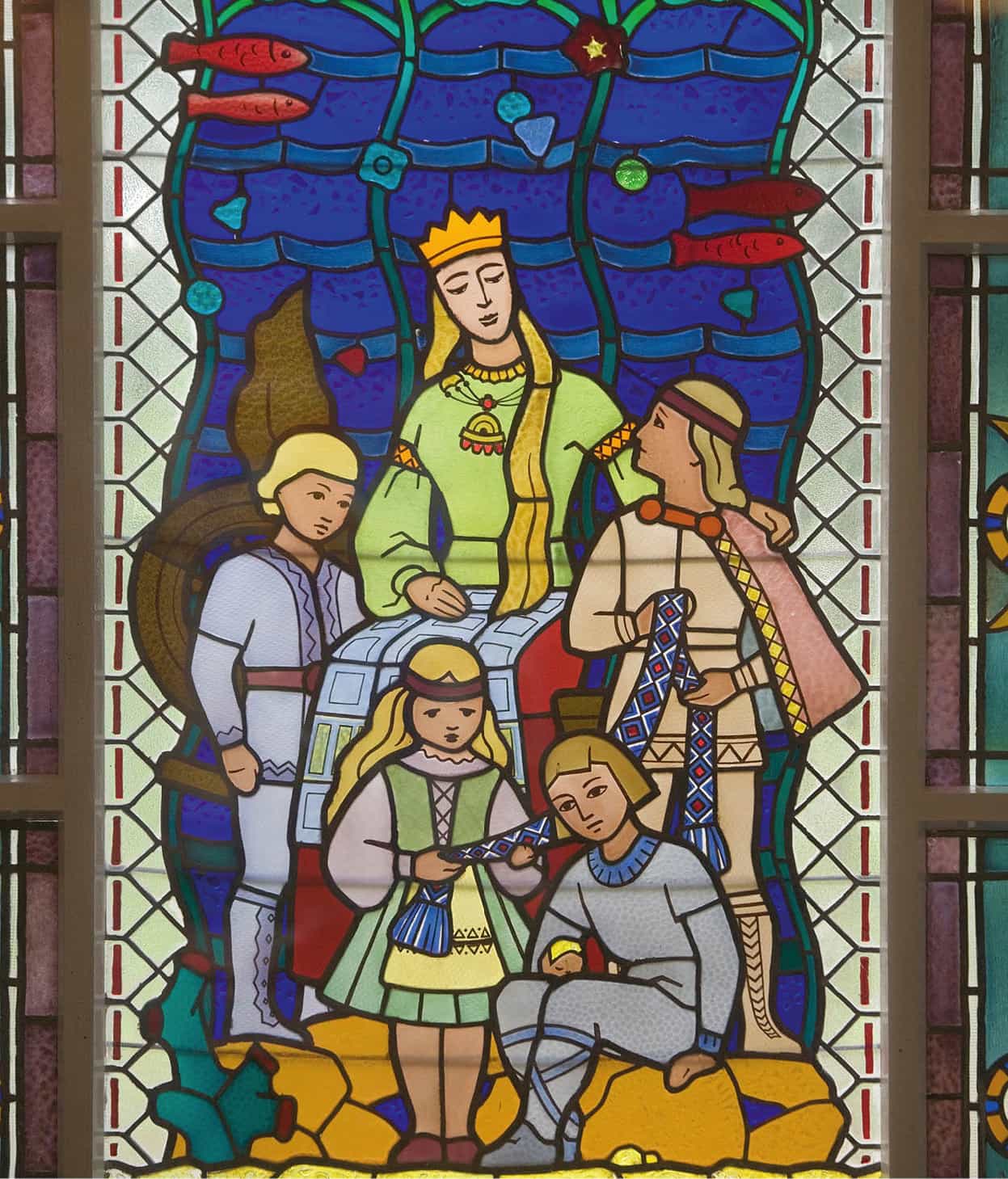
The decorative stained glass window of a spa in Druskininkai, Lithuania, tells a story.
Getty Images
Fortunately this folklore was of immense richness, especially in the field of music. Songs appear to have played an important part in the worship of the ancient Baltic gods, and ever since have been at the heart of the Balts’ sense of themselves. Almost every village has its own choir, many of a professional standard. State and public occasions often begin with folk songs. As a Latvian daina, or folk song, has it:
I was born singing, I grew up singing,
I lived my life singing.
My soul went singing
Into the garden of God’s sons.
Has a people anything dearer than the speech of its fathers? In its speech lies its whole domain, its tradition, history, religion and basis of life, all its heart and soul. Johann Gottfried Herder

Traditional Estonian costume.
Getty Images
A visit to a folk performance is recommended for any visitor. From the beginning, folklore and the Baltic national movements were entwined. The first Estonian and Latvian song festivals, in 1869 and 1873 respectively, were also political events, celebrating the end of serfdom and symbolising the reawakening and unity of the new nations. The republics between 1920 and 1940 turned them into great symbolic events. Folklore festivals became key symbols of the national independence movements in a process which has been dubbed, especially in Estonia, the “Singing Revolution”. It was at the Baltica Festival in 1987 that the old national flags of the former republics were publicly displayed together for the first time under Soviet rule and without those responsible being promptly arrested. The national song festivals are astonishing affairs, with the choirs numbered in thousands and the audiences in tens or even hundreds of thousands. Folklore was also the key to rediscovering, or reinventing, the beliefs and society of the pagan Balts that existed before the Christian conquest. These seem to have been based on the idea that the world was itself created partly through song and story-telling:
Once upon a time, the Lord God walked
through the world, telling stories and
curses, asking riddles…
The 14th-century priest Peter of Duisburg wrote that the Balts of his time “worship all of creation… sun, moon, stars, thunder, birds, even four-legged creatures down to the toad. They have their sacred forests, fields and waters, in which they do not dare to cut wood, or work, or fish.”
Spirits of the forests
Until the 18th century, Catholic priests in Lithuania were still cutting down sacred oaks in an effort to stop their worship, and until the 20th century some of the ancient spirits lived on in folk tales about forest spirits such as the leprechaun-like kaukai, the aitvarai (who can lead people to hidden treasure) and the barzdukai, a form of bearded gnome. The kaukai were originally neutral spirits who could be won over with gifts. Later, however, they came to be identified with the Christian devil. The Devil Museum in Kaunas, unique in the world, contains a magnificent collection of portrayals of the devil by Lithuanian folk artists. Unfortunately, this is also a museum of historical anti-Semitism, since most of the devils are meant to be Jewish.
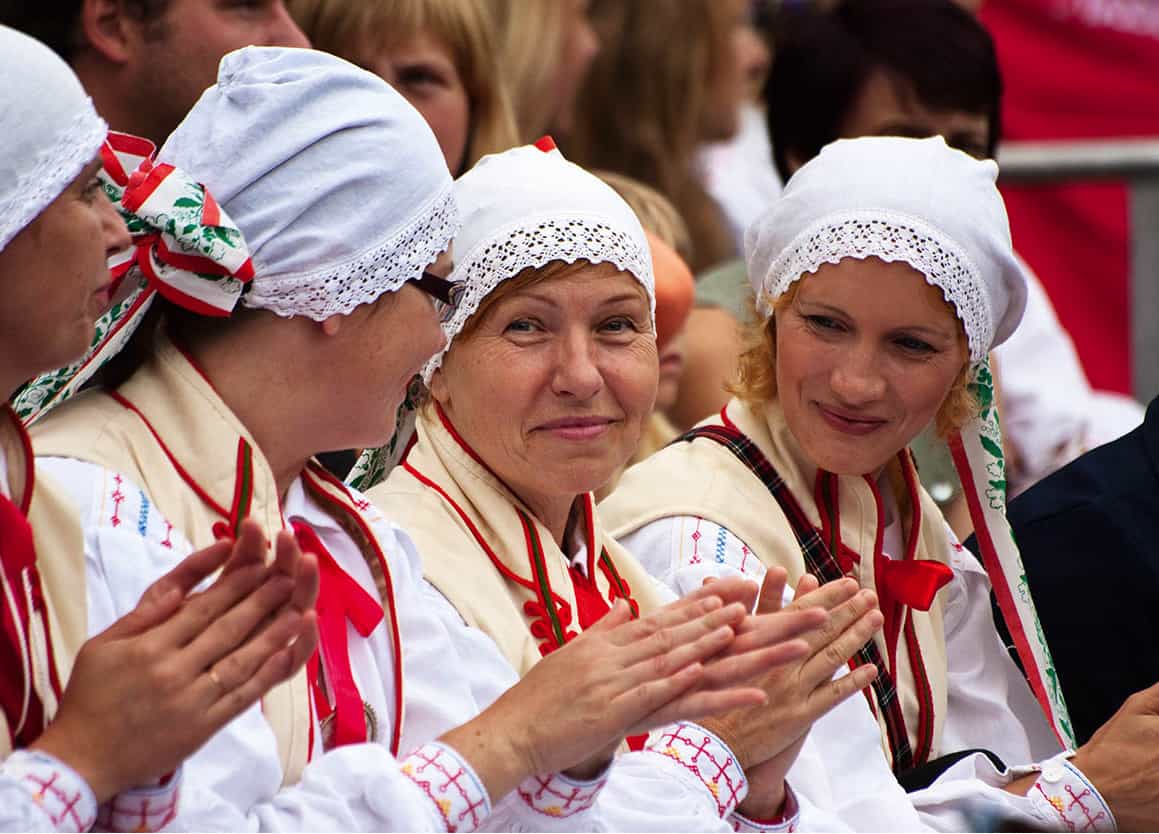
Estonia’s Voru Festival.
APA Micah Sarut
Johann Gottfried Herder
Johann Gottfried Herder (1744–1803) was born in the Prussian town of Mohrungen (Morąg), in the former Polish-Lithuanian Empire. He recognised that language played a key role in both a person’s identity and thought. While working as a teacher in Rīga, he produced Tract on the Origins of Language (1772), and his appreciation of the folk songs he collected was based on a belief that they represented a purity of spirit in peoples before civilisation. However, he warned against blind nationalism: “National glory is a deceiving seducer. When it reaches a certain height, it clasps the head with an iron band.”
By the 18th century, awareness of the old Baltic religions as such had disappeared or become completely mixed up with Christian beliefs. Thus the great pagan festival of Midsummer’s Eve was renamed St John’s Eve, but it has retained many of the old pagan legends and customs, especially those connected with fertility. One of these is that on that particular night and only then, a flowering fern appears, and if a boy and a girl find it together, it will fulfil their heart’s desire. Of course, ferns don’t flower, but the tradition is a good excuse for young couples to go off into the forest at night.
For many centuries, Christian priests and ministers did their best to stamp out much of Baltic folklore, because it embodies so much paganism. The earliest records of Latvian folk songs are provided in evidence for 17th-century witch-trials, and it has been suggested that the “witches” of this period were the linear descendants of the old pagan priests and sorcerers.
“God is a Latvian”
In the 1920s and 30s, efforts were made by some people to resurrect the old pagan religions. In Latvia, this took the form of the Dievturība movement, which continues to this day. Because in the 1930s the movement was closely associated with Latvian fascism, it was savagely persecuted under Soviet rule. Its ideology today remains intensely nationalist. “We have always believed that Latvia should be only for the Latvians,” one of its leaders has said. “God is a Latvian – or at least, our god is.”
Its theology maintains the existence of a single godhead who takes different forms. This, however, is a modern construct derived from the real, but now almost forgotten, ancient pagan religion. The Dievturi number only a few hundred, but their past sufferings and the purity of their folk singing gives them a prestige.
A certain holistic, pagan-influenced mysticism, a willingness to see divinity in all the works of nature, has characterised all three cultures up to the present day. This is true both of those authors who hark back to the ancient traditions, and those, like the Estonian poet Jaan Kaplinski, who render them into wider, universal terms – in his case, neo-Buddhist.
The new attitude to folk traditions in Europe dates to the later 18th century and the rise of Romanticism. Baltic folklore played a part in this cultural shift, because a key figure in the movement was the German philosopher Johann Gottfried Herder, who was moved by Latvian folk songs and stories when he was a Protestant minister and teacher in Rīga in the 1760s (see box).
Oral folklore and folk art
Herder’s influence led to generations of research by Baltic German scholars and, in the mid-19th century, the work was taken over by the first generations of native Baltic intelligentsia. Their task was the recording of this oral history. In Latvia, this process is linked above all with the name of Krišjānis Barons, who assembled the dainas, or Latvian folk songs. The 217,996 items form one of the largest collections of oral folklore in the world. After 1918, the governments and universities also set out to collect folk art. The Estonian National Museum in Tartu houses hundreds of thousands of examples, giving clues to an ancient tradition: for example, beer mugs were decorated with “male” symbols, such as suns and horses.
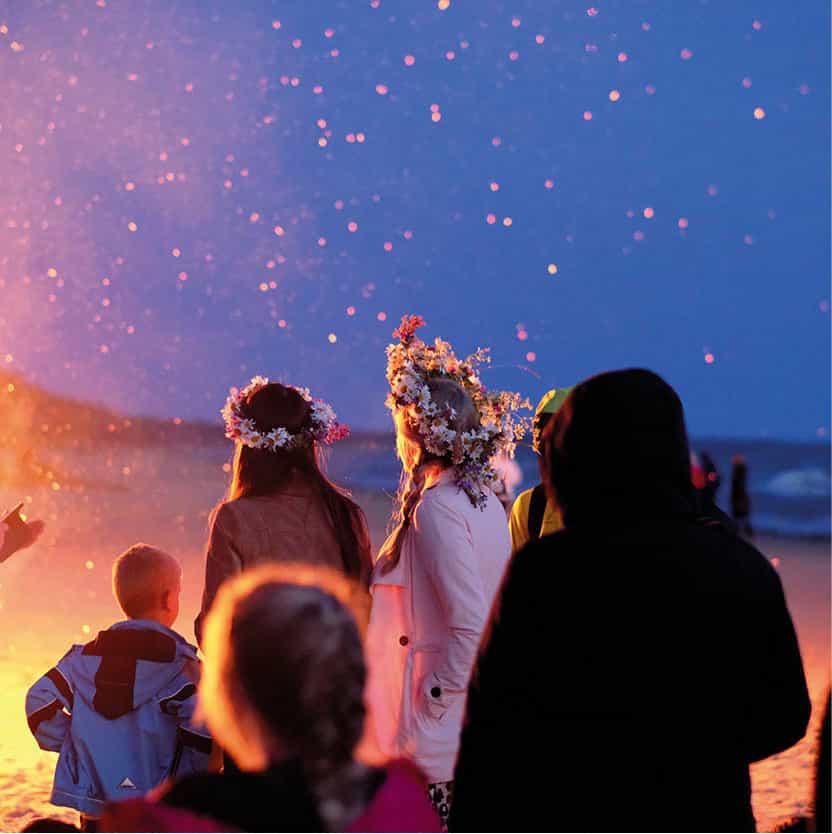
Celebrating the Summer Solstice in Latvia.
Shutterstock
Lithuania has a particularly rich tradition of folk carving, which is illustrated by the intricate wooden crosses outside many villages. Covered with ancient symbols, they resemble pagan totem poles. The carved crosses on the famous Hill of Crosses at Šiauliai is an apotheosis of Catholic piety and of Lithuanian nationalism, but also of ancient pagan symbolism.
However, the task of recovering the meaning of such figures, and the ancient Baltic tradition in general, is an intensely difficult one, both because of the suppressive effect of Christianity, and the effects of modernisation, especially Soviet rule. One reason why many Estonians wish to recover the area of Petseri, captured by Estonia from Russia in 1920 and transferred back by Stalin in 1944, is that the small Setu minority who live there have preserved folk traditions which have been lost in Estonia itself.
The first major guide to Estonian folk stories was Old Estonian Fairy Tales, published in 1866. It is still popular in Estonia, and is held to have contributed to the creation of an Estonian prose style that is independent of the German models it previously imitated.
The Thinker (Rūpintojelis), a mournful carved wooden figure often seen by the roadside in Lithuania, is presented as Christ, but is in fact much older than Christianity.
Pagan gods
Modern-day scholars have used surviving folk tales to try to establish the nature of the ancient gods and their worship. They have identified: Dievs, the principal deity; Perkūnas or Pērkons, god of thunder, akin to the Slavic Perun and the Scandinavian Thor; Saule, goddess of the sun; Laima, goddess of luck (good and bad, because Laima, like some Indian goddesses, also brings the plague); Māra, goddess of birth and death; Usins, the celestial charioteer, keeper of light; Martins, keeper of horses; Janis, who is responsible for the fertility of fields; and Ausra, goddess of the dawn.
In 1861, Kreutzwald published the “national epic” Kalevipoeg (“Son of Kalev”), a reworking in verse of stories about a giant hero; the work was intended to help build up a national spirit, and prove to a sceptical world that the Estonian folk tradition was capable of producing an epic – considered at that time to be the highest form of literature. As with the Finnish Kalevala, debate has raged over the merits of the work ever since.
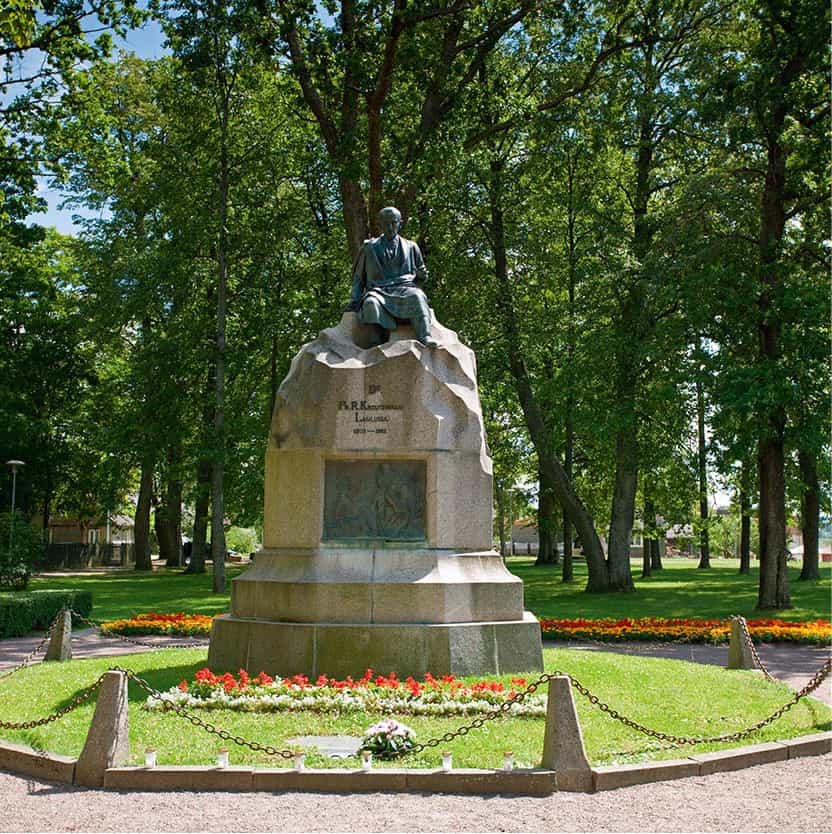
The Kreutzwald Monument, Tallinn.
Alamy
Invented gods
The Kalevipoeg is still taught in every Estonian school, but otherwise its influence has progressively diminished. This has been far less the case with the Latvian national epic, Lāčplēsis (The Bear-Slayer), by Andrējs Pumpurs, in which another mythical hero is made a leader of the medieval Latvian resistance against the German invaders. Lāčplēsis has since become the theme of a verse play by Jānis Rainis, a rock-opera and several other works. Under the first Latvian republic, the Order of Lāčplēsis was the highest state award. Kangars, the traitor in the epic, has become a generic name for traitors, while Laimdota, Lāčplēsis’ beloved, has given her name to boutiques and hairdressers, and ships and yachts are named after Spīdola, the witch.
Pumpurs also gave the ancient Latvians a pantheon of pagan gods, like the classical Olympus – quite unhistorical, but another passport to European respectability in his time. The contemporary habit of giving children “traditional” pagan names, such as Laima or Vytautas (after the Lithuanian medieval Grand Duke), dates from this period.
Today, this rich folkloric tradition is threatened by modern mass culture and by a danger that the over-use of folklore on official occasions, in schools and so on, may drain it of the joyous spontaneity which kept Baltic folklore alive and part of the region’s life. Folklore traditions have therefore become diluted, but this is the price that has to be paid for joining the global capitalist community.
The singing tree
A number of different instruments bring a distinctive sound to these lands of music and song; some have to be made with special rituals
Most traditional musical instruments are common throughout the Baltics and Eastern Europe: the goat-horn, whistle, flute, reed, violin, squeeze-box and zither. Other instruments belong to particular regions: the bagpipe in Estonia and Latvia’s Protestant area, the hammer dulcimer in Lithuania and Latvia’s Catholic part, and the hiukannel or bowed harp in the Estonian islands. But one instrument unique to the Baltic lands is a kind of board zither with between 5 and 12 iron or natural-fibre strings. Its history can be traced with some certainty back at least 3,000 years, and its Baltic names have supposedly originated from the proto-Baltic word kantlés, meaning “the singing tree”: kantele in the Finnish language, kannel in Estonian, kåndla in Livonian, kokles in Latvian and kankles in Lithuanian.
This is a deified instrument and, according to folk beliefs, the tree for its wood must be cut when someone has died but isn’t yet buried. In a fairy tale, a youth helps an old man who turns out to be God and rewards the good-hearted lad with this particular instrument.
The Apollonic, heavenly aura and the fine, deeply touching tone quality have made kokles a symbol of national music for Estonians, Latvians and Lithuanians. Unfortunately, the playing of the original instrument has almost died out. At the beginning of the 20th century, kokles developed into a zither of 25 to 33 strings, like a harp. “Modernisation” during the Soviet time resulted in a soprano, alto, tenor and bass kokles family. Compositions of questionable musical quality were played and presented as the national music.
Music festivals
A folklore revival in the 1970s and 80s restored an interest in traditional instruments. Many of them, such as the bagpipe, jew’s-harp, whistle, flute, reed, horn, clappers and rattles, are made by enthusiasts and played informally. It is now hard to imagine a celebration of calendar customs, folk-dance parties or folklore festivals without them.
The most important festivals are the summer and winter solstice celebrations, and there are large gatherings at such festivals as the Baltica, which involves all three Baltic republics. More local but no less exciting are Skamba (skamba kankliai in Lithuania) and the children’s and young people’s folklore festival, Pulkā eimu (pulkā teku in Latvia).
Sonoric meditation
In Lithuania visitors should try to listen to sutartines, which is endless sonoric meditation, both vocal and instrumental. The instrumental version of sutartines is played on kanklės, pan-pipes, trumpets or horns.
Primitive musical instruments are usually made by the players themselves. The more sophisticated ones such as the kokles, bagpipes, flutes, violins, accordions and zithers are made by a few skilled masters. These are not easy to obtain, though they can be found at fairs and folk-crafts festivals where there is also a good variety of bird-, devil- and animal-shaped clay whistles. The most popular instruments are the accordion and guitar, played at family celebrations and informal parties.
Catholic and Lutheran churches mostly have organs with distinctive characteristics. Rīga Dom’s organ is recognised worldwide, while those in rural areas can have their own unique charm.
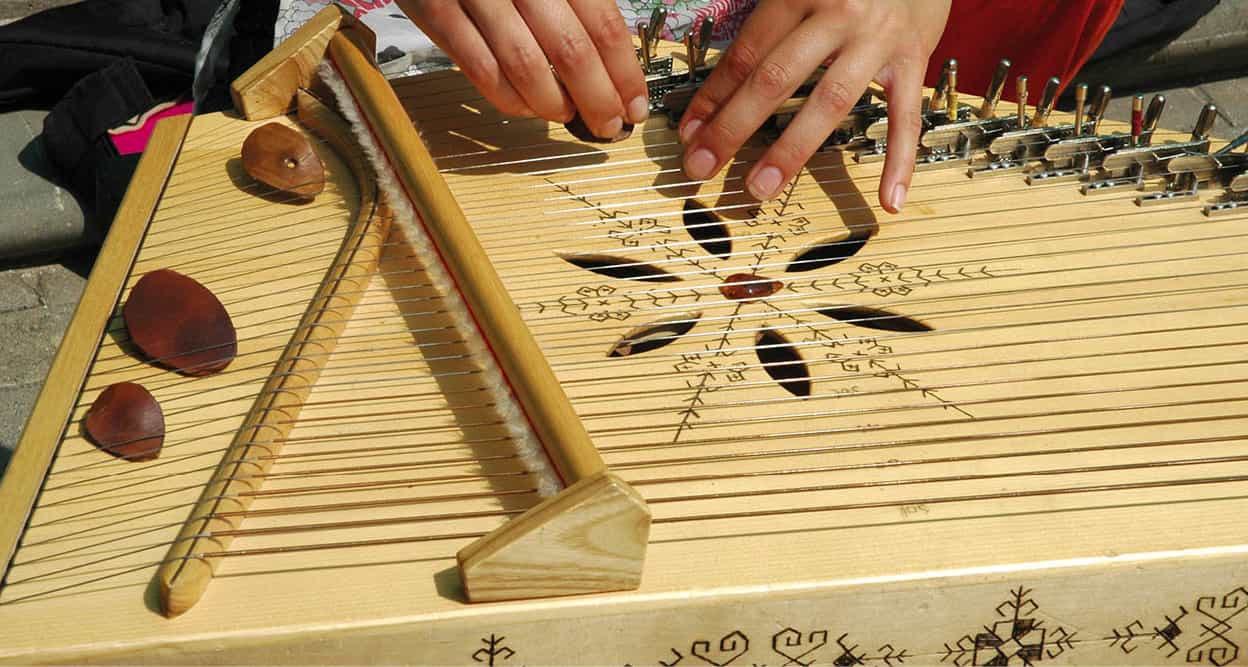
The Latvian national musical instrument, the kokle.
iStock